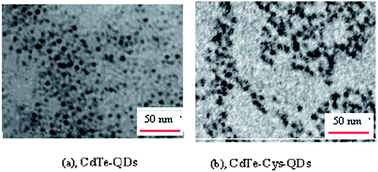Ultra-sensitive phosphorescence sensor for the detection of trace As(v) based on the signal amplification effect of As(v) catalyzing H2O2 oxidize CdTe-Cys-quantum dots
Abstract
CdTe-Cys-QDs with a grain diameter of 10.2 nm were synthesized by modifying CdTe quantum dots (QDs) using cysteine (Cys), and their structure was characterized by transmission electron microscopy (TEM), X-ray powder diffraction (XRD) and fluorescence spectroscopy. The CdTe-Cys-QDs could emit a strong and stable room temperature phosphorescence (RTP) on the polyamide membrane (PAM), and they were oxidized by H2O2 to form CdTe-Cys-QDs', resulting in increasing defects on the surface of the CdTe-Cys-QDs and the RTP signals to quench. More interestingly, As(V) can catalyze H2O2 to oxidize the CdTe-Cys-QDs, to quench the RTP signal of the system sharply, showing that the catalyzing reaction has a signal amplification effect on the RTP of the system. Based on the above phenomenom, a new CdTe-Cys-QDs phosphorescence sensor for the determination of trace As(V) has been developed. This simple, rapid and sensitive (the limit of detection (LOD) is 2.1 × 10−18 g mL−1.) CdTe-Cys-QDs phosphorescence sensor has been utilized to detect As(V) in human hair, tea and water samples, and the results are consistent with those obtained by atomic absorption spectrometry (AAS). Meanwhile, the morphological characterization changes of the CdTe-QDs and CdTe-Cys-QDs were characterized by transmission electron microscopy (TEM), X-ray powder diffraction (XRD) spectra and fluorescence spectroscopy. Furthermore, the sensing mechanism for the determination of As(V) by CdTe-Cys-QDs phosphorescence sensor was also discussed.


 Please wait while we load your content...
Please wait while we load your content...